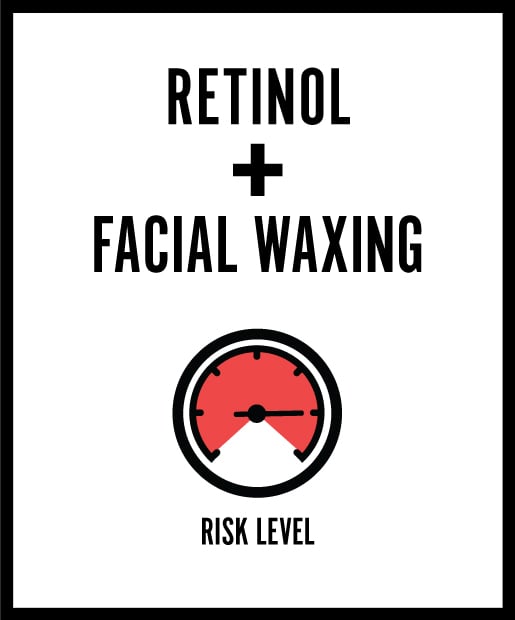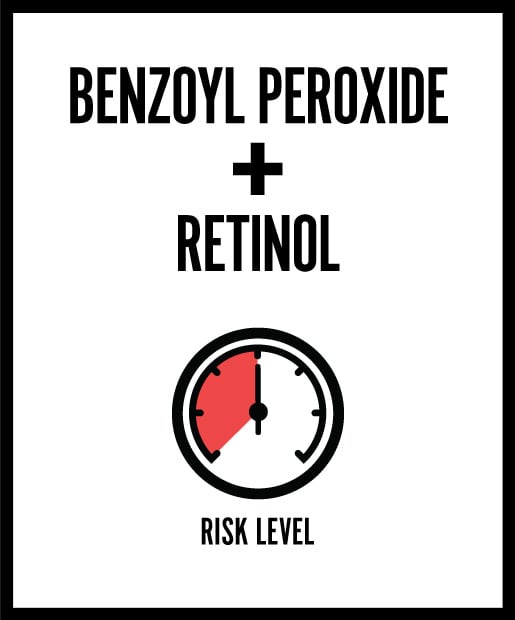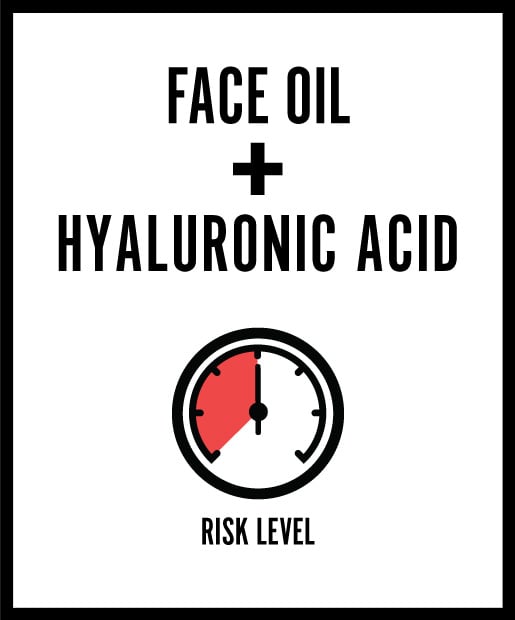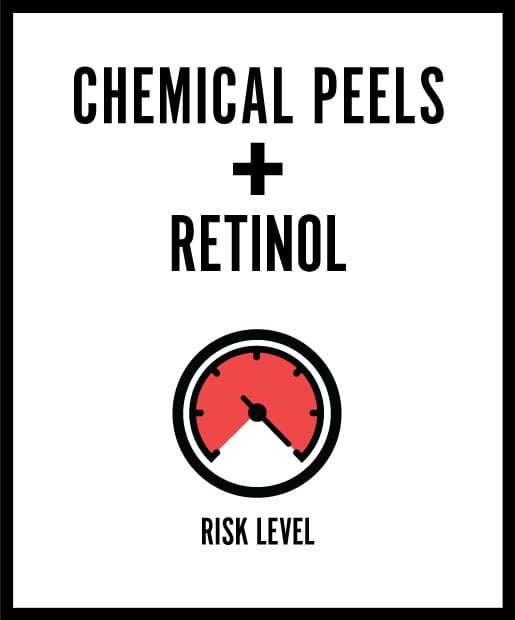Really, who doesn't have "combination" skin? I'm not talking about T-zones or the amount of oil one's skin produces. I'm talking about the battalion of products the average woman needs to combat her myriad of skin problems. When you've got wrinkles, breakouts, age spots and chapped lips at the same time, it's hard not to pile on a slew of products aimed at fighting different skin issues. But according to New York City dermatologist Jeannette Graf, M.D., assistant clinical professor of dermatology at Mount Sinai Medical Center, the concoction of products we layer on our face may not be the best recipe for great skin — in fact, it could be a recipe for disaster (kind of like the time you blew up the living room with your chemistry set).
We sat down with Dr. Graf to get the insider info on what skin care ingredients we should never mix.
Image via Imaxtree
We sat down with Dr. Graf to get the insider info on what skin care ingredients we should never mix.
Image via Imaxtree
Retinol is the powerhouse of anti-aging products. It's a form of vitamin A that encourages skin cell turnover, increasing new cell production and collagen. However, it also loosens the outer dead skin cell layer, making skin more delicate and susceptible to tearing. When hot wax is applied on top of this delicate skin, not only does it burn more easily, it can also be torn when the hot wax is removed. To avoid scabs and bloodshed at your next Brow Bar appointment, Dr. Graf recommends easing up on the retinol a week before any waxing treatment.
Readers like Rodan + Fields Night-Renewing Serum, since it contains retinol and peptides in a capsule form, giving you the same dose every application. For a stronger concentration of retinol, talk to your dermatologist about getting a prescription of Retin-A. If you've got sensitive skin, you may want to start with a gateway retinol product like RoC Retinol Correxion Sensitive Night Cream.
Readers like Rodan + Fields Night-Renewing Serum, since it contains retinol and peptides in a capsule form, giving you the same dose every application. For a stronger concentration of retinol, talk to your dermatologist about getting a prescription of Retin-A. If you've got sensitive skin, you may want to start with a gateway retinol product like RoC Retinol Correxion Sensitive Night Cream.
You'd think by the time you're contending with crow's feet that acne would be a thing of the past. But that's not the way the beauty compact crumbles. What desperate woman hasn't covered her face in both acne-zapping benzoyl peroxide and wrinkle-reducing retinol? The problem is that, like retinol, benzoyl peroxide stimulates skin cell turnover, often causing the face to flake and peel. Combining these two products is a bit like mixing Red Bull with amphetamines. It's just too much stimulation for your poor body to handle. Using retinol and benzoyl peroxide at once can lead to all sorts of problems, from extreme peeling, dryness and redness to blistering and scarring.
Dr. Graf says you can use these two products, but you should use one in the morning and one at night. She recommends sticking with a lower-concentration retinol to avoid irritation, and using it at night, since sunlight renders retinol ineffective. Use a benzoyl peroxide treatment that's no stronger than five percent during the day as a spot treatment. (Our readers give Kate Somerville Anti Bac Clearing Lotion, which contains a five percent concentration of benzoyl peroxide, a perfect "10" rating).
Dr. Graf says you can use these two products, but you should use one in the morning and one at night. She recommends sticking with a lower-concentration retinol to avoid irritation, and using it at night, since sunlight renders retinol ineffective. Use a benzoyl peroxide treatment that's no stronger than five percent during the day as a spot treatment. (Our readers give Kate Somerville Anti Bac Clearing Lotion, which contains a five percent concentration of benzoyl peroxide, a perfect "10" rating).
Though hyaluronic acid may sound like something dreamed up in a chemistry lab, it actually occurs naturally in the body. A gooey liquid that keeps your hinges from creaking, it's found in the connective tissues that keep joints lubricated. What does that have to do with your face? This acid has the ability to hold 1,000 times its weight in water, making it extremely moisturizing. It makes skin plumper, more hydrated, and reduces wrinkles.
To get all of those amazing benefits, when adding it to your skin care regimen, be sure to avoid this misstep:
"Do not apply hyaluronic acid over oil," says Dr. Graf. Why? The water-based hyaluronic acid can't penetrate the oil, meaning it can't get to your skin to do its job. If you're putting oils on before your hyaluronic acid, it's just sitting on top of that barrier. Apply your hyaluronic acid product first, and layer any facial oils (like oil-based moisturizers) on top of that. Using an oil-based cleanser before applying hyaluronic acid should be fine, as long as it's not one that you simply wipe off, since those will leave an oily residue behind that the hyaluronic acid can't penetrate.
Our readers give drugstore standby CeraVe Facial Moisturizing Lotion PM top ratings because it contains hyaluronic acid and works for any skin type.
To get all of those amazing benefits, when adding it to your skin care regimen, be sure to avoid this misstep:
"Do not apply hyaluronic acid over oil," says Dr. Graf. Why? The water-based hyaluronic acid can't penetrate the oil, meaning it can't get to your skin to do its job. If you're putting oils on before your hyaluronic acid, it's just sitting on top of that barrier. Apply your hyaluronic acid product first, and layer any facial oils (like oil-based moisturizers) on top of that. Using an oil-based cleanser before applying hyaluronic acid should be fine, as long as it's not one that you simply wipe off, since those will leave an oily residue behind that the hyaluronic acid can't penetrate.
Our readers give drugstore standby CeraVe Facial Moisturizing Lotion PM top ratings because it contains hyaluronic acid and works for any skin type.
For the same reason you shouldn't be waxing skin that has recently been treated with retinol, you also shouldn't be getting a professional chemical peel while using retinol. While both are great for decreasing the appearance of wrinkles (and retinol has even been shown to be a great weapon in the battle against acne), Dr. Graf says that the combination of the two can cause too much irritation.
Using retinol or Retin-A (the stronger, prescription form of retinol) makes the skin barrier more penetrable, which means the ingredients in a professional-grade chemical peel will get deep into your skin, fast. While you might think that sounds like a good idea, it's actually a recipe for burning and irritation, along with physical reactions like redness, peeling, crusting, swelling and blistering. A too-deep peel can even increase your chances of getting a post-peel infection, especially if you can't resist applying makeup to cover up that persistent redness. Dr. Graf says that the process of preparing for a peel varies by patient and the type and strength of the chemicals used, so talk to your dermatologist a few weeks before the peel to get an idea of the proper pre-op procedure for your skin.
Using retinol or Retin-A (the stronger, prescription form of retinol) makes the skin barrier more penetrable, which means the ingredients in a professional-grade chemical peel will get deep into your skin, fast. While you might think that sounds like a good idea, it's actually a recipe for burning and irritation, along with physical reactions like redness, peeling, crusting, swelling and blistering. A too-deep peel can even increase your chances of getting a post-peel infection, especially if you can't resist applying makeup to cover up that persistent redness. Dr. Graf says that the process of preparing for a peel varies by patient and the type and strength of the chemicals used, so talk to your dermatologist a few weeks before the peel to get an idea of the proper pre-op procedure for your skin.
Really, who doesn't have "combination" skin? I'm not talking about T-zones or the amount of oil one's skin produces. I'm talking about the battalion of products the average woman needs to combat her myriad of skin problems. When you've got wrinkles, breakouts, age spots and chapped lips at the same time, it's hard not to pile on a slew of products aimed at fighting different skin issues. But according to New York City dermatologist Jeannette Graf, M.D., assistant clinical professor of dermatology at Mount Sinai Medical Center, the concoction of products we layer on our face may not be the best recipe for great skin -- in fact, it could be a recipe for disaster (kind of like the time you blew up the living room with your chemistry set).
We sat down with Dr. Graf to get the insider info on what skin care ingredients we should never mix.







